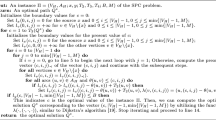Abstract
A graph matching approach to optimal assignment of task modules with varying lengths and precedence relationship in a distributed computing system is proposed. Inclusion of module precedence into the optimal solution is made possible by the use of topological module orderings. Two graphs are defined to represent the processor structure and the module precedence relationship, respectively. Assignment of the task modules to the system processors is transformed into a type of graph matching. The search of optimal graph matching corresponding to optimal task assignment is formulated as a state-space search problem which is then solved by theA* algorithm in artificial intelligence. Illustrative examples and experimental results are included to show the effectiveness of the proposed approach.
Similar content being viewed by others
References
C. C. Shen and W. H. Tsai,A graph matching approach to optimal task assignment in distributed computing systems using a minimax criterion, IEEE Trans. Computers, Vol. C-34, No. 3, pp. 197–203, Mar. 1985.
K. Efe,Heuristic models of task assignment scheduling in distributed systems, Computer, Vol. 15, No. 6, pp. 50–56, June 1982.
W. W. Chu, L. J. Holloway, M. T. Lan and K. Efe,Task allocation in distributed data processing, Computer, Vol. 13, No. 11, pp. 57–69, Nov. 1980.
H. S. Stone and S. H. Bokhari,Control of distributed processes, Computer, Vol. 11, No. 7, pp. 97–106, July 1978.
H. S. Stone,Multiprocessor scheduling with the aid of network flow algorithms, IEEE Trans. Software Eng., Vol. SE-3, No. 1, pp. 85–93, Jan. 1977.
T. C. K. Chow and J. A. Abraham,Load balancing in distributed systems, IEEE Trans. Software Eng., Vol. SE-8, No. 4, pp. 401–412, July 1982.
S. H. Bokhari,On the mapping problem, IEEE Trans. Computers, Vol. C-30, No. 3, pp. 207–214, March 1981.
Y. C. Chow and W. Kohler,Models for dynamic load balancing in a heterogeneous multiple processor system, IEEE Trans. Computers, Vol. C-28, No. 5, pp. 354–361, May 1979.
Shyue B. Wu and Ming T. Liu,Assignment of tasks and resources for distributed processing, Proc. Distributed Processing (IEEE COMPCON), pp. 655–662, Washington D.C., Sept., 1980.
Danny Dolev and M. K. Warmuth,Scheduling precedence graphs of bounded height, Journal of Algorithms, Vol. 5, pp. 48–59, 1984.
P. R. Ma, and E. Y. S. Lee, and M. Tsuchiya,A task allocation model for distributed computing systems, IEEE Trans. Computers, Vol. C-31, No. 1, pp. 41–47, Jan. 1982.
S. Kirkpatrick,Optimization by simulated annealing, Science, Vol. 220, No. 4598, pp. 671–680, May 1983.
S. Kirkpatrick, C. D. Gelatt, and M. P. Vecchi,Optimization by simulated annealing, IBM Research Report RC9355 (41093), April 1982.
S. M. Jacobs, L. V. Johnson, and O. Khedr,A technique for systems architecture analysis and design applied to the satellite ground systems (SGS), Proc. 4th Int. Conf. Distributed Computing Systems, San Francisco, CA, 14–18, May 1984.
M. J. Chung, E. J. Toy, and A. A. Lobo,A parallel computer based on cube connected cycles (an abstract), Proc. Army Research Office Workshop on Future Directions in Computer Architecture and Software, Charleston, SC, 5–7, May 1986.
M. J. Chung, et al.,A parallel computer based on cube connected cycles, RPI CIE Report Rensselaer Polytechnic Institutes Center for Integrated Electronics, Troy, NY, Mar. 1986.
W. H. Tsai,Graph matching problems: a survey and a tutorial, Proc. 1st Conf. Computer Algorithms, Hsinchu Taiwan 300, Republic of China, pp. 16.1–16.2, July 1982.
Ellis Horowitz and Sartaj Sahni,Fundamentals of Data Structures, Computer Science, Woodland and Hills, California, 1982.
N. J. Nilsson,Problem Solving Methods in Artificial Intelligence, McGraw-Hill, New York, 1971.
E. M. Reingold, Jurg Nievergelt, and Narsingh Deo,Combinatorial Algorithms: Theory and Practice, Prentice-Hall, Englewood Cliffs, New Jersey, 1977.
R. C. Read and D. G. Corneil,The graph isomorphism disease, J. Graph Theory, Vol. 1, pp. 339–363, 1977.
L. Babai, P. Erdös, and S. M. Selkow,Random graph isomorphism, SIAM J. Computing, Vol. 9, No. 3, pp. 628–635, Aug. 1980.
W. H. Tsai and K. S. Fu,Subgraph error-correcting isomorphisms for syntactic pattern recognition, IEEE Trans. Syst., Man, Cybern., Vol. SMC-13, No. 1, pp. 48–62, Jan./Feb. 1983.
R. M. Haralick and J. S. Kartus,Arrangements, homomorphisms, and discrete relaxation, Proc. IEEE Conf. Pattern Recog. and Image Processing, Chicago, IL, U.S.A., May 1978.
Author information
Authors and Affiliations
Rights and permissions
About this article
Cite this article
Wang, LL., Tsai, WH. Optimal assignment of task modules with precedence for distributed processing by graph matching and state-space search. BIT 28, 54–68 (1988). https://doi.org/10.1007/BF01934694
Received:
Revised:
Issue Date:
DOI: https://doi.org/10.1007/BF01934694




